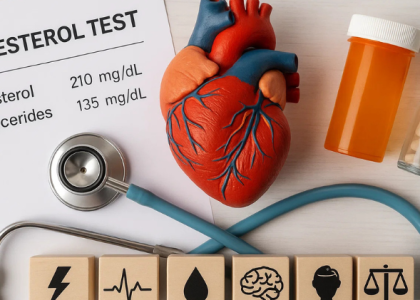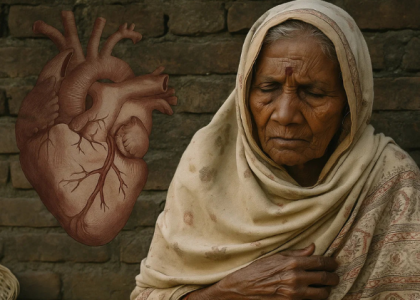Are you feeling more tired than usual? Is your dad avoiding walks because he “just gets tired too fast”? These could be signs of heart failure — and catching them early can make all the difference.
Many South Asians brush off these early warning signs as simply part of getting older or being too busy. But knowing what to look for could save your life or the life of someone you love.
What Is Heart Failure?
Heart failure doesn’t mean your heart has stopped working. It means your heart isn’t pumping blood as effectively as it should. This happens when the heart muscle weakens or stiffens over time.
Unlike a heart attack, which is sudden and often comes with chest pain, heart failure develops slowly. You might not even notice the changes at first.
According to the American Heart Association, heart failure affects South Asians at earlier ages than other ethnic groups — often 10 years earlier. This makes it even more important for us to recognize the warning signs.
Why Early Signs Are Missed in South Asians
- We blame symptoms on other things — like working too hard, aging, or stress
- We avoid regular check-ups — many people see doctors only when they’re very sick
- We have higher rates of diabetes and belly fat — which can mask or complicate heart symptoms
- Cultural attitudes — including shame about illness or pressure to “be strong”
- Language barriers — which make it harder to describe symptoms to doctors
- We focus on family duties — often putting others’ needs ahead of our own health
The Indian Council of Medical Research found that many South Asians wait until symptoms are severe before seeking help, making treatment more difficult and less effective.
Early Signs You Should Never Ignore
Breathing Changes
- Getting short of breath during everyday activities (like climbing stairs or walking to the bathroom)
- Trouble breathing when lying flat — needing to sit up to catch your breath
- Using more pillows to sleep comfortably than you used to
- Waking up at night feeling breathless
Fluid Buildup
- Swelling in your feet, ankles, legs, or stomach area
- Shoes feeling tight by the end of the day
- Sudden weight gain (2-3 pounds in a day or 5 pounds in a week)
- Needing to urinate more often, especially at night
Energy and Heart Changes
- Feeling tired all the time, even after resting
- Difficulty completing daily activities that used to be easy
- Frequent coughing or wheezing, especially when lying down
- Feeling your heart racing, pounding, or beating irregularly
- Dizziness or lightheadedness
- Loss of appetite or feeling full quickly
- Trouble concentrating or confusion (more common in older adults)
Pay special attention if: You notice several of these symptoms together, or if they get worse over time.
What to Ask Your Doctor
- “Could these symptoms be related to my heart?”
- “Would you recommend tests for heart failure, like an echocardiogram or BNP blood test?”
- “Are my blood pressure, cholesterol, and blood sugar under control?”
- “Should I monitor my weight and any swelling at home?”
- “What lifestyle changes would help my heart right now?”
- “Should I see a heart specialist (cardiologist)?”
Be specific about your symptoms and when they started. Don’t downplay them or feel embarrassed. Remember: doctors can only help with the information you share.
The Power of Early Action
Getting help early can make an enormous difference. The World Health Organization reports that early detection and treatment of heart failure can:
- Improve your quality of life — less fatigue, better breathing, more energy
- Prevent hospitalizations — fewer emergency room visits
- Slow the progression of heart damage
- Allow for gentler treatments — often starting with lifestyle changes and basic medications
- Add years to your life — many people live long, active lives with properly managed heart failure
Early treatment typically includes:
- Medications to reduce the workload on your heart
- A heart-healthy diet (especially reducing salt)
- Appropriate physical activity
- Managing other conditions like diabetes and high blood pressure
- Regular monitoring by your healthcare team
The key is to start treatment before significant heart damage occurs. As the saying goes, “It’s easier to prevent a problem than to fix it.”
Help Others, Too
- Share this symptom list on family WhatsApp groups
- Talk openly about health with parents, uncles, aunts, and older relatives
- Offer to accompany family members to doctor appointments
- Check in about medications if someone has already been diagnosed
- Cook heart-healthy meals for the whole family
- Walk together for exercise and bonding
Remember that in South Asian families, health concerns may be kept private. Approach these conversations with respect and care.
Taking Action Today
If you recognize any warning signs in yourself or a loved one, don’t wait. Early diagnosis gives you the best chance at effective treatment and a full life.
Heart failure sounds scary, but with modern medicine and lifestyle changes, most people can continue doing the activities they love. The key is catching it early — before it’s too late.
Make an appointment today, and take this article with you if it helps explain your concerns. Your future self will thank you.
Sources:
American Heart Association,
Mayo Clinic,
Cleveland Clinic,
World Health Organization,
Indian Council of Medical Research




